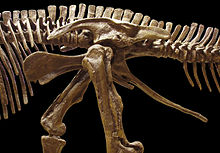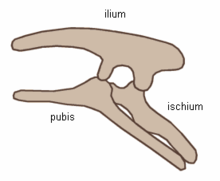
Ornithischia
Did you know...
SOS Children volunteers helped choose articles and made other curriculum material Click here to find out about child sponsorship.
| Ornithischians Temporal range: Late Triassic– Late Cretaceous, 228–65Ma |
|
|---|---|
 |
|
| Edmontosaurus pelvis (showing ornithischian structure – left side) Oxford University Museum of Natural History | |
| Scientific classification |
|
| Kingdom: | Animalia |
| Phylum: | Chordata |
| Class: | Reptilia |
| Clade: | Dinosauria |
| Order: | †Ornithischia Seeley, 1888 |
| Subgroups | |
|
|
Ornithischia (pron.: / ɔr n ɨ ˈ θ ɪ s k i ə / or-ni-THISS-kee-ə) or Predentata is an extinct order of beaked, herbivorous dinosaurs. The name ornithischia is derived from the Greek ornitheos (ορνιθειος) meaning 'of a bird' and ischion (ισχιον) meaning 'hip joint'. They are known as the 'bird-hipped' dinosaurs because of their bird-like hip structure, even though birds actually belong to the 'lizard-hipped' dinosaurs (the saurischians). Being herbivores that sometimes lived in herds, they were more numerous than the saurischians. Many were prey animals for the theropods and were usually smaller than the sauropods.
Characteristics
The Dinosauria superorder was divided into the two orders Ornithischia and Saurischia by Harry Seeley in 1887. This division, which has generally been accepted, is based on the evolution of the pelvis into a more bird-like structure (although birds did not descend from these dinosaurs), details in the vertebrae and armor and the possession of a ' predentary' bone. The predentary is an extra bone in the front of the lower jaw, which extends the dentary (the main lower jaw bone). The predentary coincides with the premaxilla in the upper jaw. Together they form a beak-like apparatus used to clip off plant material.
The ornithischian pubis bone points downward and toward the tail (backwards), parallel with the ischium, with a forward-pointing process to support the abdomen. This makes a four-pronged pelvic structure. In contrast to this, the saurischian pubis points downward and toward the head (forwards), as in ancestral lizard types. Ornithischians also had smaller antorbital fenestrae (holes in front of their eye sockets) than did saurischians, and a wider, more stable pelvis. A bird-like pubis arrangement, parallel to the vertebral column, evolved independently three times in dinosaur evolution, namely in the ornithischians, in the therizinosauroids and in bird-like dromaeosaurids.
Ornithischians shifted from bipedal to quadrupedal posture at least three times in their evolutionary history and have been shown to have been capable of adopting both postures early in their evolutionary history.
Classification
Taxonomy
The simplified taxonomic list of ornithischian groups presented here follows a summary published by Thomas R. Holz, Jr. in 2011.
- Ornithischia
- Eocursor
- Fabrosaurus
- Pisanosaurus
- Taveirosaurus
- Trimucrodon
- Heterodontosauridae – (strong-snouted dinosaurs)
- Thyreophora – (armored dinosaurs)
- Neornithischia
- Ornithopoda
- Thescelosauridae – (last primitive beaked dinosaurs)
- Iguanodontia
- Rhabdodontidae – (advanced European beaked dinosaurs)
- Dryosauridae – (small advanced beaked dinosaurs)
- Camptosauridae – (mid-sized advanced beaked dinosaurs)
- Hadrosauridae – (duckbilled dinosaurs)
- Marginocephalia
- Pachycephalosauria – (boneheaded dinosaurs)
- Ceratopsia
- Chaoyangsauridae – (early parrot-beaked dinosaurs)
- Psittacosauridae – (parrot dinosaurs)
- Neoceratopsia
- Leptoceratopsidae – (small-frilled dinosaurs)
- Bagaceratopsidae – (lump-nosed frilled dinosaurs)
- Protoceratopsidae – (deep-tailed frilled dinosaurs)
- Ceratopsidae – (horned dinosaurs)
- Ornithopoda
Phylogeny
Genasaurian ornithischians are divided into two clades: the Thyreophora and the Cerapoda. The Thyreophora include the Stegosauria (like the armored Stegosaurus) and the Ankylosauria (like Ankylosaurus). The Cerapoda include the Marginocephalia ( Ceratopsia like the frilled ceratopsidae and Pachycephalosauria) and the Ornithopoda (including duck-bills (hadrosaurs) such as Edmontosaurus). The Cerapoda are a relatively recent concept (Sereno, 1986).
The cladogram below follows a 2009 analysis by Zheng and colleagues. All tested members of Heterodontosauridae form a polytomy.
| Ornithischia |
|
|||||||||||||||||||||||||||||||||||||||||||||||||||||||||||||||||||||||||||||||||||||||||||||||||||
|
|
Cladogram after Butler et al., 2011. Ornithopoda includes Hypsilophodon, Jeholosaurus and others.
| Ornithischia |
|
|||||||||||||||||||||||||||||||||||||||||||||||||||||||||||||||||||||||||||||||||||||||
|
|

